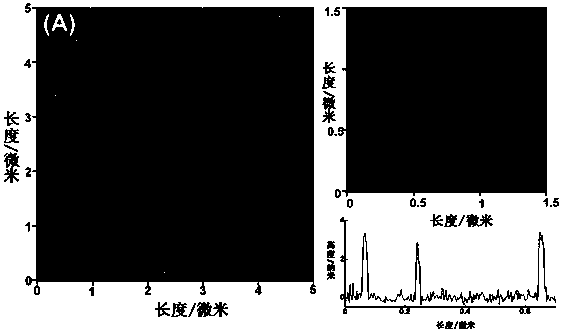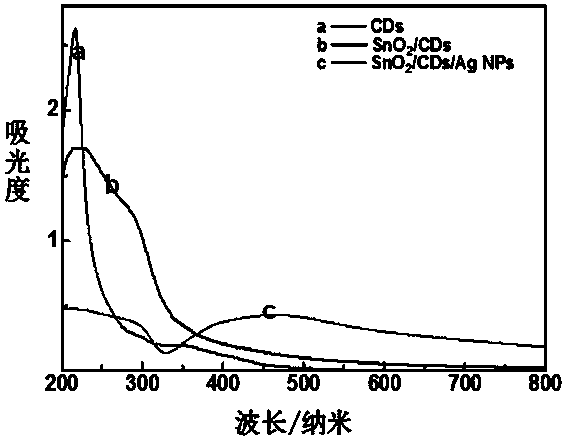Preparation method of nano tin dioxide/carbon basis point/nano silver surface-enhanced Raman substrate
A nano-tin dioxide, surface-enhanced Raman technology, applied in Raman scattering, measuring devices, instruments, etc., can solve the problems of affecting chemical enhancement effect, weakening the electromagnetic enhancement effect of materials, etc., to broaden the range of materials used and product stability. The effect of good sex and simple operation
- Summary
- Abstract
- Description
- Claims
- Application Information
AI Technical Summary
Problems solved by technology
Method used
Image
Examples
Embodiment 1
[0032] Weigh 1.8 g of single-layer graphene nanosheets with a diameter of <5 nm and dissolve them in 30 mL of water, adjust the pH to 8 with sodium hydroxide, then add 0.6 g of nano-tin dioxide solid to the above solution and mix, and the resulting mixed solution is 300W After ~700W ultrasonication for 3~4 h, centrifuge at 3000 rpm for 10 min, collect the supernatant, then centrifuge the collected supernatant at 12000 rpm for 10 min, and repeat the centrifugation and washing for 5 times until the supernatant is clear. The precipitate was dissolved in 10 mL of secondary water, that is, the carbon-based dot-wrapped tin dioxide nanosheet composite material, and stored in a refrigerator at 4 °C.
[0033]Take 1 mL of 5.5 mg / mL nano-tin dioxide / carbon based dot composite material solution and 50 mg of silver nitrate and stir and dissolve in 50 mL of deionized water, add dilute ammonia water to adjust the pH of the solution to 8, then heat the solution to 60 °C and add 100 mg of gluc...
Embodiment 2
[0035] Weigh 1.2 g of single-layer graphene nanosheets with a diameter of <5 nm and dissolve them in 30 mL of water, adjust the pH to 8 with sodium hydroxide, then add 0.6 g of nano-tin dioxide solids to the above solution and mix, and the resulting mixed solution is 300W ~700W ultrasonic for 3~4 h, centrifuge at 3000 rpm for 10 min, collect the supernatant, then centrifuge the collected supernatant at 12000 rpm for 10 min, repeat centrifugation and washing 5 times until the supernatant is clear, the obtained The precipitate was dissolved in 10 mL of secondary water, that is, the carbon-based dot-wrapped tin dioxide nanosheet composite material, and stored in a refrigerator at 4 °C.
[0036] Take 1 mL of 5.5 mg / mL nano-tin dioxide / carbon dot composite solution and 10 mg of silver nitrate and dissolve them in 50 mL of deionized water, add dilute ammonia water to adjust the pH of the solution to 8, then heat the solution to 70 °C and add 30 mg of glucose, the solution instantly ...
Embodiment 3
[0038] Weigh 0.6 g of single-layer graphene nanosheets with a diameter of <5 nm and dissolve them in 30 mL of water, adjust the pH to 8 with sodium hydroxide, then add 0.6 g of nanometer tin dioxide solids to the above solution and mix to obtain a mixed solution After ultrasonication at 300W~700W for 3~4 h, centrifuge at 3000 rpm for 10 min, collect the supernatant, and then centrifuge the collected supernatant at 12000 rpm for 10 min, and repeat the centrifugation for 5 times until the supernatant is clear. The obtained precipitate was dissolved in 10 mL of secondary water, which was the carbon-based dot-coated tin dioxide nanosheet composite material, and stored in a refrigerator at 4 °C.
[0039] Take 1 mL of 5.5 mg / mL nano-tin dioxide / carbon dot composite solution and 30 mg of silver nitrate and dissolve them in 50 mL of deionized water, add dilute ammonia water to adjust the pH of the solution to 8, then heat the solution to 80 °C and add 80 mg of glucose, the solution in...
PUM
| Property | Measurement | Unit |
|---|---|---|
| diameter | aaaaa | aaaaa |
| size | aaaaa | aaaaa |
Abstract
Description
Claims
Application Information
 Login to View More
Login to View More - R&D
- Intellectual Property
- Life Sciences
- Materials
- Tech Scout
- Unparalleled Data Quality
- Higher Quality Content
- 60% Fewer Hallucinations
Browse by: Latest US Patents, China's latest patents, Technical Efficacy Thesaurus, Application Domain, Technology Topic, Popular Technical Reports.
© 2025 PatSnap. All rights reserved.Legal|Privacy policy|Modern Slavery Act Transparency Statement|Sitemap|About US| Contact US: help@patsnap.com



